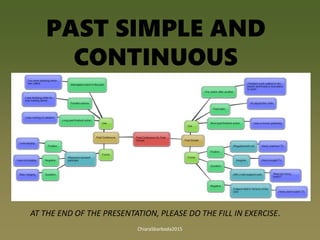Pastsimplecontinuous.
- 1. PAST SIMPLE AND CONTINUOUS AT THE END OF THE PRESENTATION, PLEASE DO THE FILL IN EXERCISE. ChiaraSbarbada2015
- 2. The PAST SIMPLE is formed by ONE verb. It can be regular or irregular. I studied English yesterday. I saw a football match last Sunday. The PAST CONTINUOUS is formed by TWO verbs: 1) Past simple of BE 2) verb +ing. I was doing my homework. ChiaraSbarbada2015
- 3. When you use SIMPLE PAST you express that the actions in the past happened one after another She came home, switched on the computer and checked her e-mails. When you use Past Continuous the actions in the past happened at the same time Simon was playing on the computer while his brother was watching TV. ChiaraSbarbada2015
- 4. When you use SIMPLE PAST you only want to mention that an action took place in the past Colin played football yesterday. When you use Past Continuous You want to put emphasis on the progress, e.g. that an action was taking place at a certain time Yesterday at six o'clock, Colin was playing football. ChiaraSbarbada2015
- 5. When my mobile rang I was sitting in a meeting. If you want to express that a new action happened in the middle of another action, you need both tenses: Simple Past for the new action and Past Continuous for the action already in progress. My mobile suddenly rang. While (mentre) I was sitting in a meeting, ChiaraSbarbada2015
- 6. 1. While Tom (play)âĶ..âĶâĶ the piano, his mother (do)âĶâĶ..âĶ the washing-up. 2. When I (be) âĶ..âĶâĶ on my way home, I (see) âĶ..âĶâĶ an accident. 3. I (fall) âĶ..âĶâĶ asleep while I (watch) âĶ..âĶâĶ TV last night. 4. Tom (break) âĶ..âĶâĶ his leg when he (play) âĶ..âĶâĶ frisbee. ChiaraSbarbada2015





